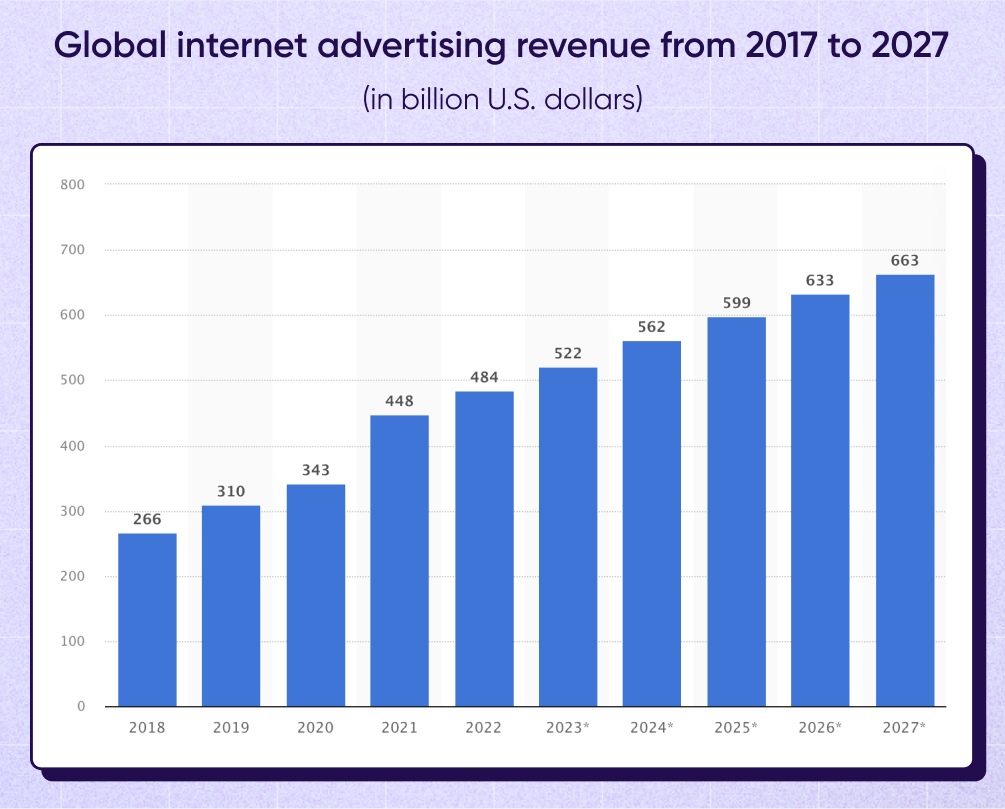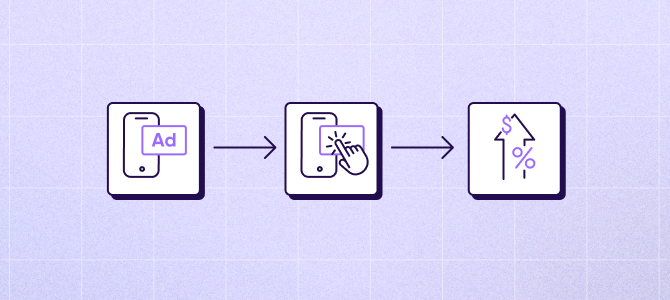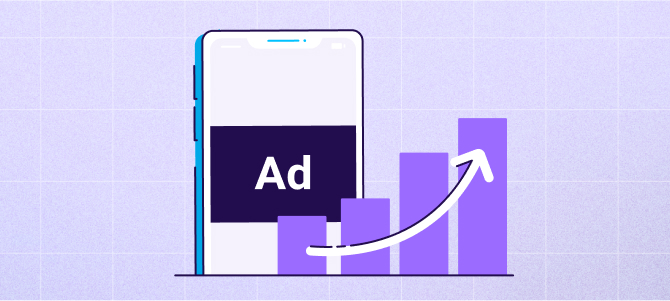
Ad revenue
In digital marketing, ad revenue is income generated through online or in-app advertising.
What is ad revenue?

Ad revenue is income generated through advertising. In the digital marketing world, this advertising may be on the web, through CTV (connected television), or within an app (more on this below).
For app and website owners looking to make the most of their digital real estate, ad revenue can be a significant source of income. Globally, internet advertising revenue has been climbing steadily in recent years, and the trend is set to continue:

App ad revenue
In-app ad revenue is an important source of income for apps today, especially when many are free to download. Think of it like the ads you see on traditional TV: You don’t have to pay to watch your favorite show, but the channel makes a profit from the commercials that you view.
The same goes for apps — with the added benefit of reaching a highly targeted and engaged audience.
With global in-app advertising expected to reach $352.70 billion in 2024, this is a market that app marketers don’t want to miss out on.
How to calculate ad revenue
The formula for calculating ad revenue is:

To break that down:
- Ad impressions refer to the total number of times an ad is displayed within the app.
- eCPM (effective cost per mille) represents the average revenue earned per 1,000 ad impressions.
When you multiply the total ad impressions by the eCPM, you can determine the overall ad revenue generated by your app.
Good ad revenue is considered one that generates a high return on investment (ROI). To achieve that, you need high eCPM, optimized ad placements, diverse ad formulas, and targeted audiences.
How does ad revenue work?

Publishers (app or website owners) generate ad revenue by selling digital ad space, known as inventory, to brands that want to get their message in front of a particular audience.
Here, we’re focusing on the app world — and different apps offer different types of inventory that serve different purposes and goals.
- Native ads: These ads make an effort to blend seamlessly into the content of an app. The benefit of this method is that it’s less intrusive and matches the look and feel of the app. Think of ads on a Facebook feed that look like regular posts.
- Display ads: This is a more traditional form of advertising that offers a range of sizes and formats, including static images or interactive media. Banner ads (see below) are a popular example.
- Video ads: An increasingly popular form of advertising, these ads are engaging and immersive. They can appear at various points in the app user journey.
- Takeover ads: These ads capture a user’s attention by taking over all, or a large portion, of the screen. While they can be effective, takeover ads must be used strategically to avoid disrupting the user experience.
- Banner ads: A staple of digital advertising, banner ads are typically rectangular ads placed at the bottom, top, or side of a mobile app.
The rise of programmatic advertising
We mentioned above that publishers sell inventory to brands looking to reach their ideal audience. Today, the majority of those deals are done using programmatic technology.
Programmatic advertising is the automated buying and selling of ad inventory. It uses real-time bidding and algorithms to match advertisers with the most relevant ad placements.
This approach allows for in-app bidding, where advertisers can compete in real-time to display their ads. Publishers can use waterfall optimization techniques to prioritize and maximize the revenue they generate from ad inventory.
The benefits of ad revenue
Ad revenue offers a number of benefits for publishers looking for an easy way to monetize their apps:
- Simple setup process: Setting up ad placements within your app is generally a straightforward process, so publishers can start earning ad revenue quickly.
- Generates revenue from otherwise dead space: All apps have unused or under-used areas. Ad placements can turn these “dead spaces” into revenue-generating opportunities.
- Easy to optimize: Optimize ad revenue over time by testing different ad formats, placements, and targeting strategies.
- Scalable: Ad revenue potential increases over time as an app’s user base grows.
- Attracts more viewers: Ads can help drive more traffic and engagement to your content, as users are incentivized to interact with the ad-supported experience.
- Diversifies income streams: It’s always good to have multiple income streams. Adding ad revenue together with other strategies, including in-app purchases and subscriptions, means you don’t have to rely on a single source of revenue.
- Offers insights into user behavior: By monitoring how users interact with your app, you can better understand your audience and optimize content and monetization strategies.
The disadvantages of ad revenue
Despite all the advantages, ad revenue does come with a few pitfalls that publishers need to watch out for:
- Reduced control over what appears on your content: You have less control over the specific advertisements displayed on your app when relying on ad networks to fill ad inventory.
- Volatility of revenue based on traffic: Ad revenue is directly related to the amount of traffic and engagement an app receives. Fluctuations can lead to a drop in ad revenue.
- Risk of turning off your audience with non-relevant ads: Displaying ads that aren’t relevant or appealing to your audience can negatively impact the user experience and potentially drive users away.
- Difficulty of striking the right balance: It can be hard to maximize ad revenue while maintaining a positive user experience. With too many in-app ads, customers may become frustrated and therefore less engaged.
How to increase ad revenue

There are a variety of tactics that can help increase ad revenue in apps:
- Focus on the user experience: Users come to the app for its purpose, not to consume ads. It’s important to make ads relevant and non-intrusive to keep audiences engaged and loyal, which in time can boost ad revenue.
- Learn about — and experiment with — ad placement: Strategically placing ads in high-visibility areas of an app, and testing the ad placements, can up ad performance significantly.
- Create original content and update it regularly: By keeping an app up to date and interesting, publishers can attract and retain a loyal audience. This will lead to more ad impressions and higher revenue potential.
- Optimize the number of ads displayed: Try to find the sweet spot between number of ads and great user experience.
- Measure performance: Monitor metrics such as eCPM, click-through rates, and overall ad revenue so you can make data-driven optimizations.
- Diversify ad types and formats: Using a variety of ad types and formats can attract a wider range of advertisers, as well as keeping things interesting for users.
- Choose the right partners: It’s important to partner with reputable ad networks and platforms that offer competitive rates, advanced targeting capabilities, and reliable fill rates to boost ad revenue.
- Offer exclusive sponsorships: Gain reliable and potentially higher-value revenue streams by giving sponsorship opportunities to select advertisers.
Increasing ad revenue with AppsFlyer
AppsFlyer helps you boost your ad revenue through more accurate marketing performance measurement. This improved visibility lets you focus on data to make better decisions together with ad partners, optimizing profits and results for both sides.
Key takeaways
- Ad revenue is income generated from advertising. In the digital marketing world, this includes ads on web, CTV, and in apps.
- In-app advertising is an important revenue stream for mobile app developers, offering access to highly engaged, targeted audiences.
- The formula to calculate ad revenue is: Ad revenue = Ad impressions x eCPM. A good ad revenue is one that brings a strong return on your investment.
- Publishers generate ad revenue by selling ad inventory, which is available in various forms such as native ads, display ads, video ads, takeover ads, and banner ads.
- Programmatic advertising, including in-app bidding and waterfall optimization, is a significant part of the ad revenue landscape.
- Benefits of ad revenue include a simple setup process, monetizing otherwise unused space, scalability, and diversification of income streams. Ads can also increase traffic to your content, while user data and insight helps you optimize your app.
- Disadvantages include reduced control over ad content, revenue volatility based on traffic, ad blocking, and the challenge of balancing ad revenue with user experience.
- Tactics to increase ad revenue include focusing on the user experience, experimenting with ad placements, creating original content, optimizing ad numbers, measuring performance, and choosing the right partners. AppsFlyer can support you by providing accurate and visible performance data, leading to better decision-making.


